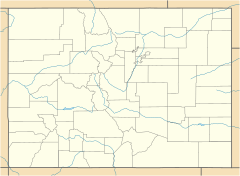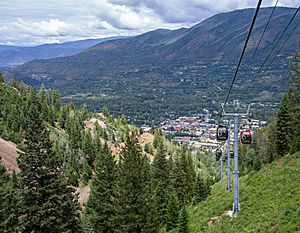Aspen Mountain (ski area) facts for kids
Quick facts for kids Aspen Mountain |
|
|---|---|

"Ajax" in April 2005
|
|
| Location | White River National Forest Aspen, Pitkin County, Colorado, U.S. |
| Nearest city | Aspen |
| Coordinates | 39°11′11″N 106°49′7″W / 39.18639°N 106.81861°W |
| Vertical | 3,267 ft (996 m) |
| Top elevation | 11,212 ft (3,417 m) |
| Base elevation | 7,945 ft (2,422 m) |
| Skiable area | 673 acres (2.7 km2) |
| Runs | 76 total |
| Longest run | 3 miles (5 km) |
| Lift system | 8 total - 1 gondola - 1 high-speed quad chair - 1 high-speed triple - 1 quad chair - 2 double chairs - 2 secondary lifts |
| Lift capacity | 10,755 / hr |
| Snowfall | 300 in (760 cm) |
| Snowmaking | 31% of area |
| Night skiing | none |
| Website | aspensnowmass.com |
Aspen Mountain, often called Ajax by local people, is a super cool place to ski in the western United States. It's located in Pitkin County, Colorado, right near the city of Aspen. This ski area is on the north side of Aspen Mountain itself, sitting high up at about 11,212 feet (3,417 meters) above sea level!
Aspen Mountain was started way back in 1946 by Walter Paepcke. It was the very first ski area created by the Aspen Skiing Company. Today, it's one of four ski areas run by the company as part of the Aspen/Snowmass group. Even though it's a bit smaller than other ski areas, especially compared to the huge Snowmass nearby, Aspen Mountain has a special feeling. It reminds people of the early days of skiing in Colorado. The ski area is inside the White River National Forest and works with permission from the U.S. Forest Service. You can find three restaurants on the mountain, two at the top and one in the middle.
The Story of Aspen Mountain
Before 1946, people skied on Aspen Mountain using a simple boat lift or by driving jeeps up the back roads. In 1941, Aspen hosted its first big national ski races. The idea for the ski area really took off in 1946 when they built the first chairlift, called Lift-1. When it opened on December 14, 1946, it was the longest chairlift in the world! Many of the first workers were veterans from the 10th Mountain Division, a special army unit that trained in the mountains. These included Friedl Pfeifer from Austria and Pete Seibert. Pfeifer had led a ski school before the war and did the same at Aspen. Seibert, who was part of the Aspen ski patrol, later started Vail Mountain in 1962. Just four years after opening, Aspen hosted the 1950 World Ski Championships. This was the first time these championships were held outside of Europe.
Lift-1 was used until 1972. Then, it was replaced by two new chairlifts: Shadow Mountain (often called 1A) and Ruthie's. Getting up the mountain changed a lot in 1986 with the new Silver Queen Gondola. This gondola goes all the way to the top, climbing 3,267 feet (996 meters)! The ski area also has other lifts, including a fast quad chair, a fast triple chair, two regular quad chairs, and three double chairs.
The Silver Queen Gondola and the Little Nell chairlift both start from Gondola Plaza in the middle of downtown Aspen. This means visitors can go up the mountain right from town and ski back down the Little Nell Run. You can still see old signs of silver mining from the 1880s and 1890s hidden around the mountain. In January 2001, Aspen Mountain decided to allow snowboarding after a long ban. However, to be fair to people who had season passes, it didn't officially open to snowboarders until April 1, 2001.
The longest ski run on Aspen Mountain is 3 miles (4.8 km) long. The lifts can carry 10,755 skiers every hour. On average, the mountain gets 300 inches (7.6 meters) of snowfall each year. They can also make snow on about 210 acres (0.84 km²), which is about one-third of the ski area. Aspen Mountain is known for its challenging slopes. It has no "green" (beginner) runs at all. If you are a beginner skier, you should go to Snowmass or Buttermilk. About 26% of the terrain is considered expert level. The ski season usually runs from late November to early April. It's often one of the last ski areas in the resort to close for the winter.
Aspen Mountain has a special, friendly feeling that comes from its early days. This unique culture is seen in the many homemade memorials and tributes found in the trees. These are often made in honor of famous people like John Denver and Hunter S. Thompson.
Mountain Slopes
- North: 50%
- East: 23%
- West: 27%
Fun in the Spring!








